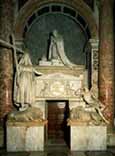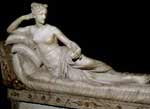 Antonio Canova was born on 1st November 1757 in Possagno and trained in Venice, where he executed some of his first works (classical-style representation of Orpheus and Eurydice, Dedalus and Icarus and Apollo).
Antonio Canova was born on 1st November 1757 in Possagno and trained in Venice, where he executed some of his first works (classical-style representation of Orpheus and Eurydice, Dedalus and Icarus and Apollo).
In 1779 he went to Rome, where he attended the school of nudes in the Academy of France and the Museo Capitolino.
Canova followed the neoclassical principles of Winckelmann in his drawings and works of sculpture. Some of his drawings are: Study of the group of Castor and Pollux, Nude Man on a Boulder and Two female nudes.
His first statue in Rome was Theseus and the Minotaur, commissioned by the ambassador of the Repubblica Veneta Girolamo Zulian.
Theseus is sitting on the Minotaur after the battle, symbolising the victory of reason over irrationality.
In his works of sculpture Canova sought ideal beauty, i.e., beauty born from the artist’s idea of perfection which cannot be found in nature. To represent ideal beauty through art, knowledge and imitation of classical art are necessary, as well as considerable knowledge of carving materials.
For this reason the artist’s works of  sculpture, always in marble and sometimes covered with amber or pink wax, to imitate skin colour, are always so smooth they are almost shiny.
sculpture, always in marble and sometimes covered with amber or pink wax, to imitate skin colour, are always so smooth they are almost shiny.
This is particularly obvious in the sculpture of Love and Psyche, currently in the Louvre Museum in Paris.
The sculpture is the moment Love wakes Psyche just before kissing her. It is a highly refined and sensual work of sculpture.
Other works of sculpture of the same sort are Hebe, Venus and Adonis and the three Graces, where sensual elegance is combined with the perfect balance of the composition, typical of the neoclassical culture.
Canova worked on funeral monuments, like the Monument of Clement XIII in St Peter’s, the Monument of Clement XIV in Santi Apostoli, the funeral stone of Volpedo (where Friendship is shown weeping by the bust of the deceased).
In 1798 duke Albert of Sassonia-Teschen commissioned a funeral monument for Maria Cristina of Austria. The monument is shaped like a pyramid and was probably inspired by the Caio Cestio pyramid in Rome, built in the I century BC.
There is a funeral procession bearing the ashes of the deceased in front of the pyramid. A portrait of the deceased is on the medallion above the door, held by Earthly Happiness.
Canova was summoned to Paris in 1802 by Napoleon, who commissioned a bust-portrait of himself (only some plaster moulds  remain of this today). He executed a nude of Napoleon as the god Mars, bringer of peace, which the emperor did not like.
remain of this today). He executed a nude of Napoleon as the god Mars, bringer of peace, which the emperor did not like.
He carved the portrait of PaolinaBorghese as Winning Venus. Venus holds the golden apple given to her by Paris because he considered her the most beautiful goddess. Paolina is lying on cushion and is sitting upright; the upper part of her body is naked and covered in pink wax, to make it look more life-like. The sculpture has the typical coldness deriving from the accurate representation in neoclassical style.
At the end of the Napoleonic age Canova returned to Rome. Works dating from this period show changes in the artist’s style: there is more emotion in his works, which reveals he was influenced by the emerging Romantic movement. Works from this period are: Magdalene, the Lamentation over the Dead Christ, the Stuart Monument and Venus and Mars.
Antonio Canova died in Venice in 1822.